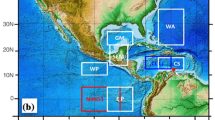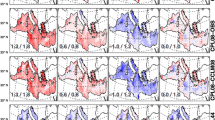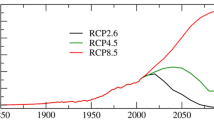Abstract
This study examines a future climate change scenario over California in a 10-km coupled regional downscaling system of the Regional Spectral Model for the atmosphere and the Regional Ocean Modeling System for the ocean forced by the global Community Climate System Model version 3.0 (CCSM3). In summer, the coupled and uncoupled downscaled experiments capture the warming trend of surface air temperature, consistent with the driving CCSM3 forcing. However, the surface warming change along the California coast is weaker in the coupled downscaled experiment than it is in the uncoupled downscaling. Atmospheric cooling due to upwelling along the coast commonly appears in both the present and future climates, but the effect of upwelling is not fully compensated for by the projected large-scale warming in the coupled downscaling experiment. The projected change of extreme warm events is quite different between the coupled and uncoupled downscaling experiments, with the former projecting a more moderate change. The projected future change in precipitation is not significantly different between coupled and uncoupled downscaling. Both the coupled and uncoupled downscaling integrations predict increased onshore sea breeze change in summer daytime and reduced offshore land breeze change in summer nighttime along the coast from the Bay area to Point Conception. Compared to the simulation of present climate, the coupled and uncoupled downscaling experiments predict 17.5 % and 27.5 % fewer Catalina eddy hours in future climate respectively.




Similar content being viewed by others
References
Brands S, Taboada JJ, Cofino AS, Sauter T, Schneider C (2011) Statistical downscaling of daily temperature in the NW Iberian Peninsular from global climate models: validation and future scenarios. Clim Res 48:163–176
Diaz-Nieto J, Wilby RL (2005) A comparison of statistical downscaling and climate change factor methods: impacts on low flows in the River Thames, United Kingdom. Climatic Change 69:245–268
Dodge Y (2013) The Oxford dictionary of statistics terms, OUP. ISBN 0-19-920613-9
Giorgi F, Jones C, Asrar GR (2009) Addressing climate information needs at the regional level: the CORDEX framework. WMO Bulletin 58(3):175–183
Held IM, Soden BJ (2006) Robust responses of the hydrological cycle to global warming. J Climate 19:5686–5699
Ho C, Park T, Jun S, Lee M, Park C, Kim J, Lee S, Hong Y, Song C, Lee J (2011) A projection of extreme climate events in the 21st century over East Asia using the community climate system model 3. Asia Pac J Atmos Sci 47(4):329–344
Hong SY, Moon NK, Lim KSS, Kim JW (2010) Future climate change scenarios over Korea using a multi-nested downscaling system: a pilot study. Asia Pac J Atmos Sci 46(4):425–435
Hurkmans R, Terink W, Uijlenhoet R, Torfs P (2010) Changes in streamflow dynamics in the Rhine basin under three high-resolution regional climate scenarios. J Climate 23:679–699
Juang HMH, Kanamitsu M (1994) The NMC nested regional spectral model. Mon Wea Rev 122:3–26
Juang HMH, Hong SY, Kanamitsu M (1997) The NCEP regional spectral model: an update. Bull Amer Meteor Soc 78:2125–2143
Kanamitsu M, Kanamaru H (2007) Fifty-Seven-Year California reanalysis downscaling at 10 km (CaRD10). Part I: system detail and validation with observations. J Clim 20:5553–5571
Kanamitsu M, Yoshimura K, Yhang Y, Hong S (2010) Errors of interannual variability and multi-decadal trend in dynamical regional climate downscaling and its corrections. J Geophys Res 115, D17115
Kanamitsu M, Yulaeva E, Li H, Hong SY (2013) Catalina eddy as revealed by the historical downscaling of reanalysis. Asia-Pacific J Atmos Sci 49(4). doi:10.1007/s13143-013-0042-x
Koenigk T, Doscher R, Nikulin G (2011) Arctic future scenario experiments with a coupled regional climate model. Tellas 63A:69–86
Li H, Kanamitsu M, Hong SY (2012) California reanalysis downscaling at 10 km using an ocean–atmosphere coupled regional model system. J Geophys Res 117, D12118. doi:10.1029/2011JD017372
Li H, Kanamitsu M, Hong SY, Yoshimura K, Cayan DR, Misra V (2013) A high-resolution ocean–atmosphere coupled downscaling of a present climate over California. Clim Dyn. doi:10.1007/s00382-013-1670-7
Rodgers JL, Nicewander WA (1988) Thirteen ways to look at the correlation coefficient. Am Stat 42(1):59–66
Shchepetkin AF, McWilliams JC (2005) The regional oceanic modeling system (ROMS): a split-explicit, free-surface, topography-following-coordinate ocean model. Ocean Model 9:347–404
Stigler SM (1989) Francis Galton’s account of the invention of correlation. Stat Sci 4(2):73–79
Sun F, Roderick ML, Lim WH, Farquhar GD (2011) Hydroclimatic projections for the Murray-Darling Basin based on an ensemble derived from Intergovernmental Panel on Climate Change AR4 climate models. Water Resour Res 47: W00G02, doi:10.1029/2010WR009829
Timbal B, Dufour A, McAvancey B (2003) An estimate of future climate change for western France using a statistical downscaling technique. Clim Dyn 20:807–823
Vecchi GA, Soden BJ (2007) Global warming and the weakening of the tropical circulation. J Climate 20:4316–4340
Yoshimura K, Kanamitsu M (2009) Specification of external forcing for regional model integrations. Mon Wea Rev 137:1409–1421
Zhao Z, Chen SH, Kleeman MJ, Mahmud A (2011) The impacts of climate change on air quality-related meteorological conditions in California. Part II: present versus future time simulation analysis. J Climate 24:3362–3376
Acknowledgments
This work was supported by grants from National Oceanic and Atmospheric Administration (ECPC: NA17RJ1231, NA12OAR4310078, NA10OAR4310215, NA11OAR4310110), the California Energy Commission PIER Program, U.S. Geological Survey (06HQGR0125), and U.S. Department of Agriculture (027865). The views expressed herein are those of the authors and do not necessarily reflect the views of funding agencies. Supercomputing resources were provided by the Center for Observations, Modeling and Prediction at Scripps Institution of Oceanography and TACC via Extreme Science and Engineering Discovery Environment. The help of Kathy Fearon in refining our text is appreciated. Three anonymous reviewers helped to improve the manuscript.
Author information
Authors and Affiliations
Corresponding author
Additional information
Masao Kanamitsu is deceased
Rights and permissions
About this article
Cite this article
Li, H., Kanamitsu, M., Hong, SY. et al. Projected climate change scenario over California by a regional ocean–atmosphere coupled model system. Climatic Change 122, 609–619 (2014). https://doi.org/10.1007/s10584-013-1025-8
Received:
Accepted:
Published:
Issue Date:
DOI: https://doi.org/10.1007/s10584-013-1025-8




